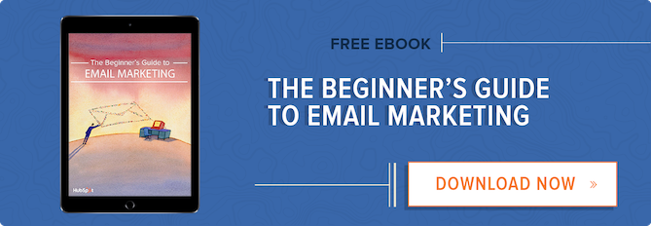So you’ve spent a better part of your day setting up your email for an upcoming marketing campaign. You’ve carefully picked the right images and spaced everything out perfectly; it looks great in HubSpot. But then you send yourself an email and find that it’s not looking quite like you expected.
Emails can sometimes render differently based on email clients using their own HTML and CSS standards, which can cause a discrepancy between the appearance of the email in HubSpot compared to how it looks in your inbox.
But what should you do if your email appears one way in HubSpot and another way in your inbox? Below are some troubleshooting steps you can follow to resolve some of the common email appearance issues that we see.
Put Your Email to the Test
Using your HubSpot in-app email testing tool is the first step when you don’t have access to a particular email client (such as Apple Mail or different versions of Outlook). With this tool, you can compare how the email looks across clients and how it looks in HubSpot so that you can pinpoint what's incorrect.
To use the email testing feature:
- In the left sidebar menu of the email editor, click on the check mark icon.
- Click Test your email and select which email clients you’d like to test this email in.
- At the bottom of the screen, select Test my email now.
- Once the test has finished running, you can select the different thumbnail images to see the email preview for each of your selected email clients.
When testing your emails this way, it’s important to keep in mind that there are limits for how many tests can be performed per month—check out this article here for more details.
Adjust Your Spacing
While the padding and margin you set in HubSpot will work in some email clients (as well as in web versions of the email), Outlook doesn't support padding or margin styles. Instead, we can use hspace and vspace. Hspace adds spacing to the right and left of an element, and vspace adds space on the top and bottom of an element.
To add this, you'll need to open the source code of the email because this needs to be added within the <img> tag. In the email editor, you can access the source code within the email editor by clicking the </> button in the editing toolbar (shown below).
The higher the value attributed to vspace and hspace, the more space you provide to that image.
When adding hspace or vspace, we recommend that you start by adding the rule to one element and then use the “test in email clients” tool. If it doesn't work, try adding the hspace or vspace to the element beside it. Like the scientific method, we're trying to rule out what could be causing an issue and what fixes it. More information about hspace and vspace can be found here.
Using Tables
In addition to using hspace or vspace, you can also use tables to lay out your content.
Tables for images
Tables help to restrict widths so that images will not appear disproportionately large in Outlook.
To insert your image into a table, start by selecting the image in the email editor.
Then, select the Table option in the editing toolbar followed by Insert table. Select a 1 x 1 table so that we create a single table cell for the image.
You'll then see the table surrounding the image, as shown below:
When adding images to your tables, be sure they don’t exceed the width of the email. For a single image, you want a maximum of 600px. If you’re putting two images side by side, then those images should be 300px maximum each.
Tables help to align elements
If Outlook is causing unexpected spacing between the elements in the email, such as pushing a section of text down when it should be aligned with another section, try inserting the all of the text into a table.
Making tables responsive
If you use a table in emails or on a page, make sure that the table is responsive. To do this to an existing table:
- Open the source code of the email or page.
- Find <table> in the source code, and in the style tag, add width:100%; height:auto;.
For example: <table style=”width:100%; height:auto;”> - Find each <td> (these are the table cells). Make sure their percentages add up to 100% since you've set the table to 100%.
For example, if you have three table cells aligned next to each other, set each <td> as:
<td style=“width:33.3%; height:auto;”>
(remove any widths/heights they're setting).
Making the heights equal to auto and keeping the widths percentages can help align text next to each other when they may get distorted otherwise.
You can also set this up for a new table by navigating to the editing toolbar and selecting Table > Insert table.
Then, add your content into your table cells:
Here's what the source code looks like before our width edits:
And here's the source code after updating the width and height rules of the table and table elements:
This will result in the responsiveness shown below:
This HubSpot community post provides additional context on using percentage widths to help with mobile responsiveness.
Additional Resources
Now that you've brushed up on some email design tips and tricks, remember to always be learning and check out the articles below.
Which CSS rules are supported by which email clients:
https://www.campaignmonitor.com/css/
Why do emails look different in Outlook?:
https://knowledge.hubspot.com/articles/kcs_article/email/why-do-emails-look-different-in-outlook
Tips and tricks for styling emails for Outlook in HubSpot:
https://blog.hubspot.com/marketing/prepare-emails-outlook-tricks
Email design FAQ:
https://knowledge.hubspot.com/email-user-guide-v2/common-email-design-questions-and-best-practices


![How to Size Images for Your Blog Content [HubSpot Support Series]](https://www.hubspot.com/hubfs/375_Size%20Images.png)
![3 Service-focused Workflows to Empower Your Support Team [Support Series]](https://53.fs1.hubspotusercontent-na1.net/hubfs/53/service%20button.jpeg)

![How to Add Your Branding to a Marketplace Template [Support Series]](https://53.fs1.hubspotusercontent-na1.net/hubfs/53/Support/Support%20Series%20User%20Blog%20folder%20copy%202.png)
![Creating a Custom Date-Based Property Report [Support Series]](https://53.fs1.hubspotusercontent-na1.net/hubfs/53/Support/HubSpot%20Support%20Series%20Horizontal-603978-edited.png)
![Advanced Troubleshooting: The Network Tab [Support Series]](https://53.fs1.hubspotusercontent-na1.net/hubfs/53/HubSpot%20User%20Blog/HubSpot%20Support%20Series%20Horizontal.png)
![How to Update an Incorrect PDF Title [Support Series]](https://53.fs1.hubspotusercontent-na1.net/hubfs/53/HubSpot%20User%20Blog/Photo%20editors%20using%20laptop%20in%20meeting%20room%20at%20office-1.jpeg)